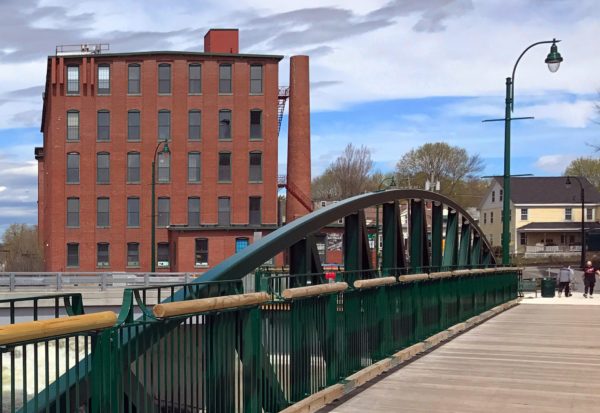By David Webster.
There are many reasons for renovating older buildings. For me, seeing buildings as a major contributor to the character of a place is a reason to renovate rather than replace. They represent the history of a community; why and how a community evolved, what the economic drivers were, what the people in the community valued. I also hate throwing things out, especially things that are rich with historical stories.

New Pedestrian Bridge over Presumpscot River in Westbrook connects two sides of the downtown. Dana Warp Mill is a historic mill built in the late 1800s as a woolens mill and now houses offices and businesses.
Renovating buildings is both gratifying and challenging. Reusing a building is usually more sustainable than tearing it down and building its replacement. Most historic buildings, which are the most challenging to renovate, are found in town centers where commercial activity was located and limited means of transportation kept housing close by. Breathing new life into historic buildings represents an opportunity for the community to reinvent itself without losing its identity. Honoring history will do that. That is where the gratification comes from.
The challenge is in renovating without ruining the building. They really don’t “build them like they used to.” 150-year-old masonry buildings were built to last. To continue that legacy, we need to understand historic construction methods and materials. Our contemporary impulse, of course, is to insulate. But an old masonry wall that has been kept warm and dry by heat moving from the interior to the exterior won’t respond well. Insulation introduces a freeze-thaw cycle that causes spalling brick. Wood beams from old-growth forests too, may have very different qualities from today’s wood. So, the challenge is in taking the time and putting in the effort to understand the building and its materials.
In a way, the science of understanding an old building is like designing in an established community. The challenge is to understand its history and evolution.
David Webster is a Principal at PDT Architects and on the board of GrowSmart Maine.
Multiple sessions at our 2017 Summit on 10/18 in Westbrook cover historic renovation and preservation:
- 9:00 a Breathing New Life into Old Buildings: historic renovation walking tour in downtown Westbrook
- 1:00p When We Invest: Developer, Philanthropy & Community Perspectives from Dover-Foxcroft, Eastport and Nationwide
- 3:15p Bridging Historic Preservation, Farmland Conservation, Outdoor Recreation & the Arts
Join us at our biggest event of the year for these and other conversations important to Maine communities.
